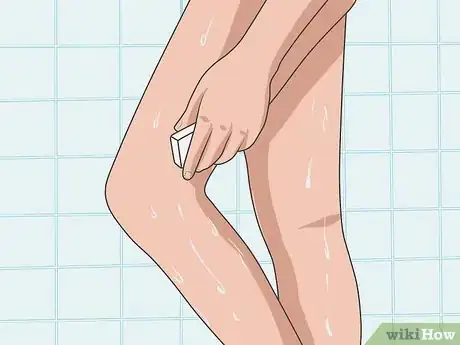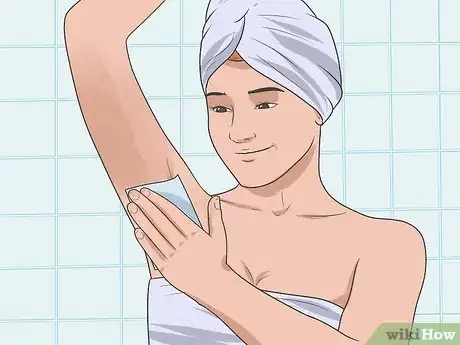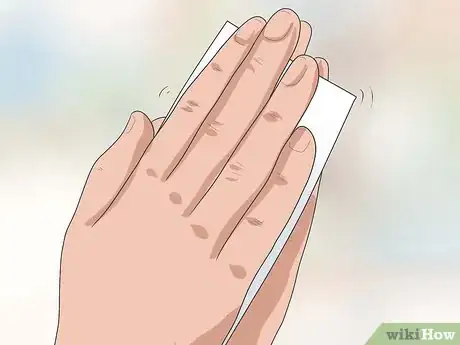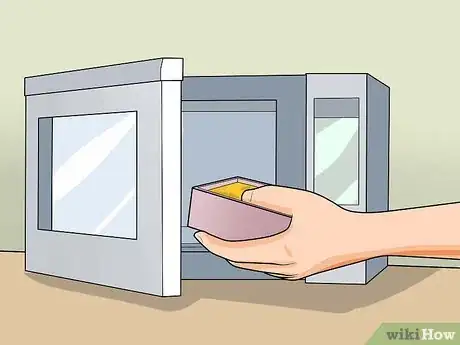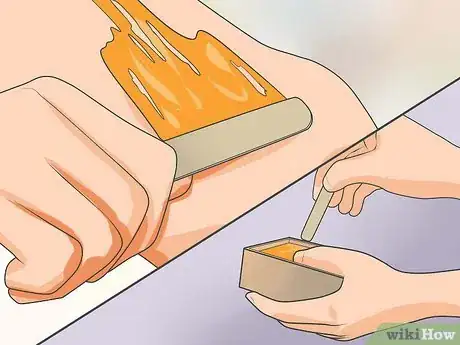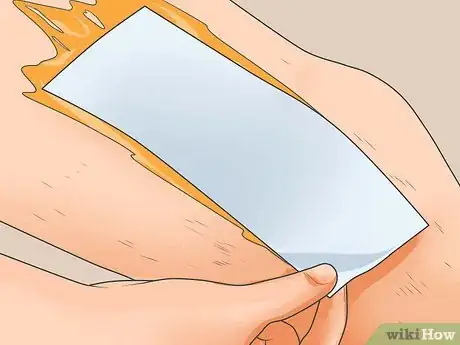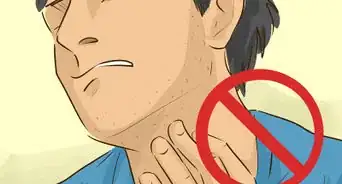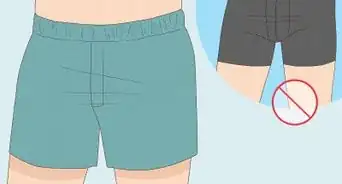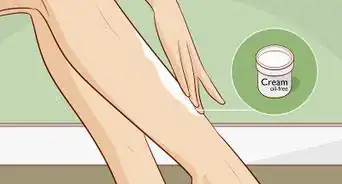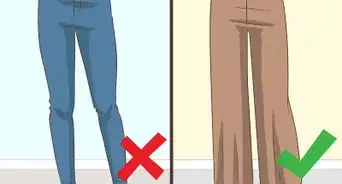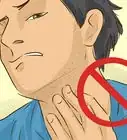This article was co-authored by Mohiba Tareen, MD. Mohiba Tareen is a board certified Dermatologist and the founder of Tareen Dermatology located in Roseville, Maplewood and Faribault, Minnesota. Dr. Tareen completed medical school at the University of Michigan in Ann Arbor, where she was inducted into the prestigious Alpha Omega Alpha honor society. While a dermatology resident at Columbia University in New York City, she won the Conrad Stritzler award of the New York Dermatologic Society and was published in The New England Journal of Medicine. Dr. Tareen then completed a procedural fellowship which focused on dermatologic surgery, laser, and cosmetic dermatology.
There are 7 references cited in this article, which can be found at the bottom of the page.
This article has been viewed 184,339 times.
Going to a salon to get hair removed can be costly and time consuming. However, you can remove hair with wax at home. There are two basic ways to do this, and neither is very complicated. We'll walk you through how to use either premade wax strips or wax you heat up yourself to remove unwanted hair.
Steps
Preparing the Skin for Waxing
-
1Exfoliate your skin. Whether you are using a premade wax strip, or if you are using hot wax that you heat up, you should exfoliate your skin about a day before you plan to wax.
- Use a loofah or scrub to get rid of dead skin so the wax can grip the hairs better. Then, wash the area with a regular soap and water, and make sure it is completely dry.[1]
- After cleansing your skin, sprinkle a bit of baby powder to the area about to be waxed. It'll absorb any excess moisture so the wax and cloth strip can adhere properly.
- Waxing can be done on the upper lips, under arms, arms, legs, stomach, back, and bikini line.[2] Any lotions or makeup on the skin may prevent the wax from removing the hair.
-
2Reduce the chances of skin sensitivity. There are some simple tips that might make the waxing process less painful for you. You might want to explore more options for hair removal than waxing, too.[3]
- If you have sensitive skin, you can take an ibuprofen half an hour before you begin. Be prepared to spend about an hour waxing as this is not something you want to rush.
- If you menstruate, try not to wax right before or during your period; your skin may be much more sensitive, and it could be significantly more painful.
- Don't wax if you're currently dealing with any pimples, infections, or open sores or you could irritate your skin and make the problem worse.[4]
Advertisement -
3Wax in a warm environment. A good choice would be to do the waxing in your bathroom after a shower.
- If you wax in a cold environment, it’s going to be a more painful process. Warm air helps your follicles stay open, and the hair will slide out more easily. This applies to plucking your eyebrows, too!
- Go several days without shaving the area you want to wax; you will have best results when the hair is at least 1/4 inch long.
Using a Premade Wax Strip
-
1Warm the strip by rubbing it between your hands for several seconds. Rewarm strips as necessary, and discard these when they are no longer effective.[5]
- Next, slowly separate the layers, exposing the wax. The benefit of wax strips is that they don’t require you to heat up the wax.
- The downside is that some people consider them more painful than hot wax because the wax remains cold.
- Choose the right wax strips. If you are using pre-coated wax strips, make sure you are using the correct kind for the area you are waxing. You don't want to use a leg waxing strip on your bikini line or on your face.
-
2Apply the strip to the area to be waxed, and quickly smooth it down in the direction of hair growth. Put the strip wax side down.
- For example, a wax strip applied on the legs should be applied with pressure moving downwards because leg hair grows downwards.
- You want to press firmly on the strip, until the wax cools against the skin. This should just take a few seconds.
-
3Hold the skin taut at the bottom of the strip, and quickly rip the strip against the direction of hair growth. Be sure to keep the strip as close to the skin as possible while removing it.
- Don't wax the same place twice. Ripping the strip against the direction of hair growth pulls the hair from the root, ensuring thinner hair growth. The waxed region should remain hair free for about 2 weeks.
- Keep the skin taut as the discomfort subsides. Any wax left over can easily be washed off later. Remove excess wax from the skin with baby oil. Some people develop rashes once waxed.
Using Wax You Heat Up Yourself
-
1Warm the wax. If you are using soft wax in a pot, depending on the kind you use, you may need a wax pot to warm it, or you can simply warm it in the microwave. For a full jar, heat it about 15 to 20 seconds. For a half jar, heat for about 10 seconds. The consistency of the contents should be a little thicker than maple syrup.
- Make sure to follow microwaving directions to the letter to prevent the wax from getting too hot and burning your skin. Make sure it's not too hot, as it can burn you.[6]
- If you have the tub of wax, you would need to get yourself some wax paper (which you can find at pretty much any grocery or dollar store), and a popsicle stick or two, preferably the thicker variety.[7]
- You will also need muslin or other fabric strips to use with the wax. Always test your wax by applying a bit to the inside of your wrist to make sure it's at a comfortable spreading temperature. Too cold and it won’t spread; too hot, and you'll burn yourself.
- Be sure to follow the instructions carefully, heating and stirring at intervals to avoid boiling the wax, as overheating can cause it to break down and not work as well for future uses.
-
2Dip the applicator into the warm wax. This usually comes with the wax kit. It looks like a tongue depressor. Or you could use a popsicle stick to spread some of the now warm and liquid wax on your body part of choice.
- Apply a thin layer to the skin in the same direction of the hair growth. Quickly apply the cloth strip, and smooth down in the direction of the hair growth; you should have these ready so that the wax doesn't harden on your skin while you are fishing around for your strips.
- The wax shouldn't be too thin or too thick, but the more the hair, the more wax you should use. The more wax you use, the more painful the process can be, though.
-
3Apply the fabric over the wax in the direction of hair growth, leaving enough free fabric at the end to grasp the strip firmly. Smooth the strip down with one hand. Pull the skin taut and quickly rip off the strip. You want to rip it off in the opposite direction of the hair growth.
- You may immediately apply pressure to the skin with your hand to help soothe the nerve endings. Use another cloth strip to remove any leftover wax from the skin.
- Don't go slow, as that's one of the worst things you can do. Brace yourself and yank fast.
- If the hair does not come off, possible reasons include short hair (too short for waxing); too hot wax; or wax pulled in the wrong direction; not enough wax applied
Community Q&A
-
QuestionCan I use the Veet cream, and then a wax strip to wax?
 Community AnswerIts not needed to use a wax strip to wax after using Veet cream because Veet itself gives a complete touch. After using Veet you are supposed to use a soothing natural moisturizer to keep the softness of the skin intact.
Community AnswerIts not needed to use a wax strip to wax after using Veet cream because Veet itself gives a complete touch. After using Veet you are supposed to use a soothing natural moisturizer to keep the softness of the skin intact. -
QuestionWhat am I doing wrong if the hair doesn't come off?
 Community AnswerIt's possible that the wax isn't hot enough or you are leaving the strip on your skin for too long. Make sure that when you place the wax strip on your skin, you only leave it for a few seconds before taking it off.
Community AnswerIt's possible that the wax isn't hot enough or you are leaving the strip on your skin for too long. Make sure that when you place the wax strip on your skin, you only leave it for a few seconds before taking it off. -
QuestionWhere should I keep the remaining wax strips after use to keep their stickiness?
 QuenelleCommunity AnswerYou cannot use a wax strip twice. But if you have remaining unused wax, just store it at room temperature.
QuenelleCommunity AnswerYou cannot use a wax strip twice. But if you have remaining unused wax, just store it at room temperature.
Warnings
- Never wax over the same spot more than once. It will cause irritation, swelling and redness⧼thumbs_response⧽
- Always test the wax or strips on a non-conspicuous area of skin before first use.⧼thumbs_response⧽
- If you have sensitive skin, this may not be the approach for you.⧼thumbs_response⧽
References
- ↑ http://www.totalbeauty.com/content/gallery/p-at-home-waxing
- ↑ http://www.marieclaire.com/beauty/a14039/lasering-versus-waxing/
- ↑ http://www.webmd.com/beauty/hair-removal/for-women-only-best-choices-for-hair-removal?page=3
- ↑ Mohiba Tareen, MD. Board Certified Dermatologist. Expert Interview. 26 March 2020.
- ↑ https://www.youtube.com/watch?v=0I0JvVPtb0A
- ↑ http://www.womenshealthmag.com/beauty/new-waxing
- ↑ http://www.dailymotion.com/video/xpv3gg_hair-removal-waxing_lifestyle
About This Article
There are two main methods for at home hair waxing: premade wax strips or wax you heat. With premade strips, you warm them up for a moment in your hands and apply it to the desired area. Wax you heat gives you more freedom and accessibility since you apply it directly to your skin then cover with a fabric strip. In both cases, apply the wax product in the direction of your hair growth going towards your feet and pull it towards your head when removing. For additional hints and pain preventative steps, read on!
